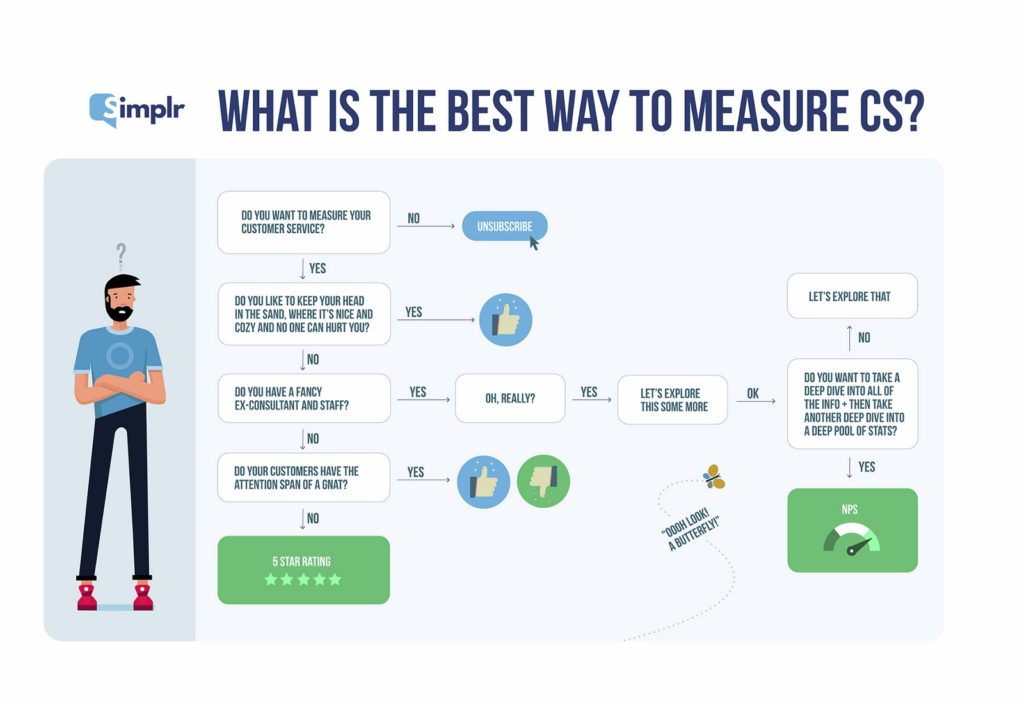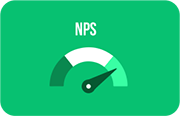How to Measure Customer Service Success: Stars, Smileys, and Thumbs
[Updated January 27, 2022]
It is easy to get lost with all the different rating systems, let’s make it Simplr for you.
Customer service is paramount for small businesses — a great experience can make a customer loyal for life, while a bad experience can send them packing (or worse… online reviewing).
Regardless of which industry you operate in, it is critical to measure your customer experience to determine the effectiveness of your customer service approach and identify areas of improvement.
In the old days, gauging customer satisfaction depends on how customers responded to the business’ marketing strategies. An advertisement is deemed effective if more people are buying the product or subscribing to a service.
A consumer’s opinion is usually collected using a questionnaire survey. Other businesses call their customers directly to ask about their post-sales experience.
Today, young and old alike know how to point and click on a smartphone to shop, reach out to customer service, and leave a review of their experience. All it takes is a mobile device for your customers to write about your business and share how they feel about your product or service through social network sites. The information can spread like wildfire across social media websites.
The good news is, it has also become easier to solicit feedback from customers about their experience with your business. You can send email surveys, integrate a feedback form on your web page, incorporate an automated question that appears at the end of a chat session with your customer service agent, or engage in digital marketing research.
Measuring customer experience is a good way to learn more about consumer behavior – your customers’ attitude in buying, what affects their decision-making process, and what drives brand loyalty.
In this article, we will explore some of the best ways to measure your customer’s experience.

Thumbs
Thumbs have always been a swift and simple way to say “good” or “bad.” Thumbs determined the fate of gladiators in ancient Rome and let a generation of moviegoers know which films were worth the cost of admission (and another generation knows what to watch or skip on Netflix). More recently, Facebook has taught us the value of a simple blue-thumbed “like.” Thumbs are an effective and quick way to measure customer satisfaction. Here’s a closer look:
1. Thumbs UP
The thumbs-up sign emoji demonstrates approval. It is almost always conveniently used in a Facebook messenger conversation or text messaging to express agreement, liking, or satisfaction with the service provided.

Pros
· It’s easy! = Higher response rate.
Cons
· Only captures positive feedback, with no variability of how much you like it
· To rate agents, you need to calculate # of likes divided by # of inquiries.
2. Thumbs up/Thumbs Down
Seeing a thumbs-down reaction from your customers is the easiest way to tell that they had a bad user experience from your business. A bad experience not only affects your sales but also provides your competitors an opportunity to take away your customers.

Pros
· Opens the door for negative feedback
· Simple 2 options = higher response rate
· A great measure of effectiveness of content (Netflix shifted to thumbs up/thumbs down for rating videos)
Cons
· Doesn’t capture the sentiment of a positive review: was it stellar or just ok?
· Doesn’t describe the full scale of your customer’s emotion. Are they happy or dissatisfied with the entire service or just a part of it?
· To rate agents, you need to devise your own scoring system that weighs thumbs up and thumbs down. This may be difficult for your agents to understand.
A 5-Star/Smiley Rating

5-star ratings are pervasive in customer service-driven companies such as Uber, Lyft, and Care.com. Similar to thumbs, they transcend language barriers and elicit a quick response. Customers have a broader range of response options, which gives your business stronger data.
Pros
· Gives customers freedom to express how they really feel (e.g., “good” or “excellent”)
· Easily convertible to the NPS scale. More on that in a bit.
Cons
· Response rate may go down with more options
· Differentiating the scores can be tricky. What’s the difference between a 4.1 and a 4.4?
· Customers tend to vote in extremes — either a 1 or a 5. This creates diluted data, similar to thumbs up and thumbs down.
NPS — Net Promoter score

NPS has traditionally been the gold standard in measuring overall customer satisfaction. By simply asking “On a scale of 0–10: How likely are you to recommend this service to a friend?” your business can tap a wealth of data that can be benchmarked against other companies.
Pros
· It’s tried and true.
· Helps spark discussions on what will “wow” customers and what can be done to eliminate detractors.
Cons
· NPS has been around for a long time, so customers are more knowledgeable about the scale and know how to game it
· The standard NPS question is broad and sometimes customers associate NPS at the brand level not with the specific level of service that a specific agent provided them with.
How to convert a 5 point system to NPS:
NPS Score 10 = 5 Stars
NPS Score 9 = 4.5 Stars
NPS Score 8 = 4 Stars
NPS Score 7 = 3.5 Stars
NPS Score 6 = 3 Stars
NPS Score 5 = 2.5 Stars
NPS Score 4 = 2 Stars
NPS Score 3 = 1.5 Stars
NPS Score 2 = 1 Star
NPS Score 1 = 0.5 Stars
NPS Score 0 = 0 Stars
Other Ways to Measure Customer Service Experience
Integrating a smiley facial feedback widget is another popular way to analyze end user feelings. It provides real-time data that can help you in determining what kind of emotion your customers experience after dealing with your agents.
Similarly, customer satisfaction score (CSAT) analysis can indicate brand loyalty and advocacy.
Tap on your customers’ emotions by providing excellent customer support.
Nothing beats a top-performing customer service experience. A fuss-free money-back guarantee offer may help retain dissatisfied customers, but it still won’t do much if your customer support agents are negligent or not knowledgeable enough to handle disputes, complaints, and angry customers.
Go the extra mile to serve your customers. Provide a Contact Us page on your business website. Respond to customer inquiries timely on social media. Make your web portal design easy to navigate. Be transparent about your data collection management and privacy policy. Create a culture of excellence in your workplace to inspire and motivate employees. Offer a complete onboarding process for your new hires so they know how to deal with unhappy customers. These strategies are applicable not only in retail but also in many other business models.
Despite the increasing automation processes in today’s business environment, consumers desire human interaction, especially when looking for a solution to their problem. They don’t contact your customer support simply out of boredom or to take out their anger on someone. They reach out because they have a question to ask before making a purchase or they encounter a problem post-purchase. The best thing that you can do for them is to respond timely and provide a solution to their problem.
At Simplr, our first goal is to make sure our SMBs and enterprises are at least using something to collect feedback. We know some platforms charge extra for this feature and that every penny counts, which is why on our platform we let you send surveys to customers for free, whether you use your own agents or ours.
For most of our customers, our recommendation is the five point scale and then we leave it up to you on whether stars or smiley faces are a better fit for your brand.
